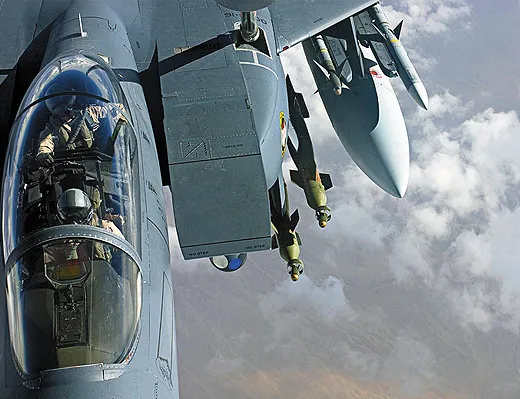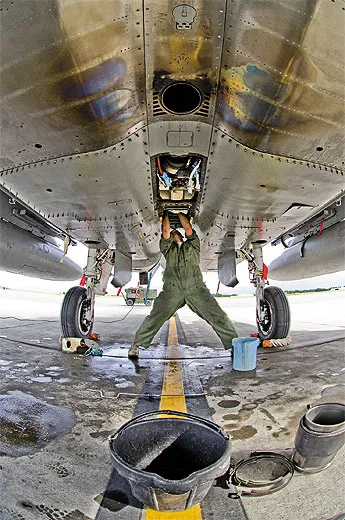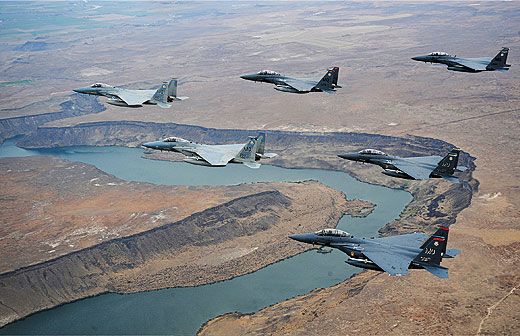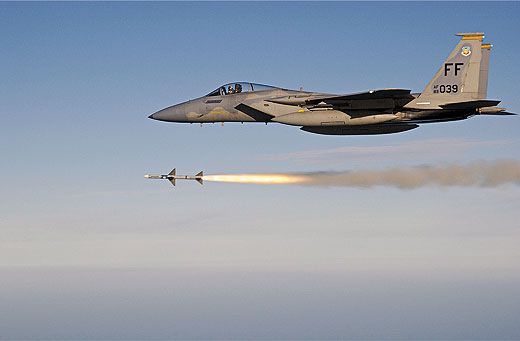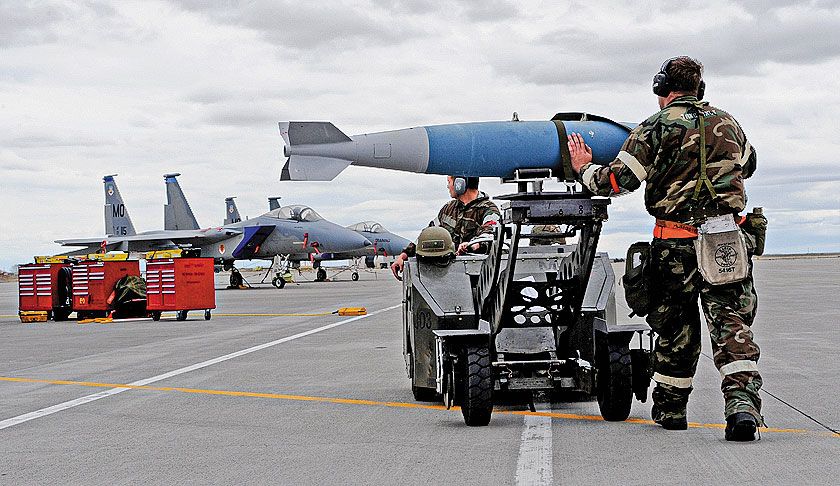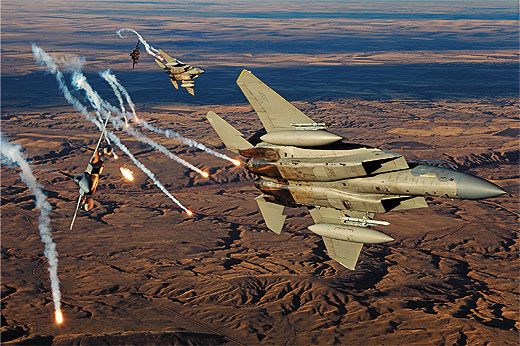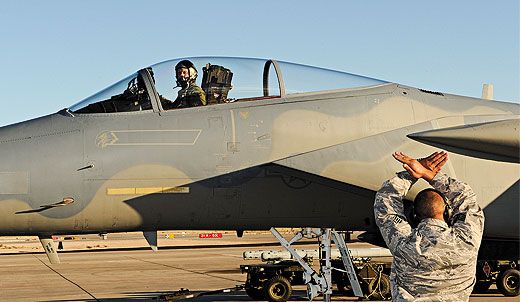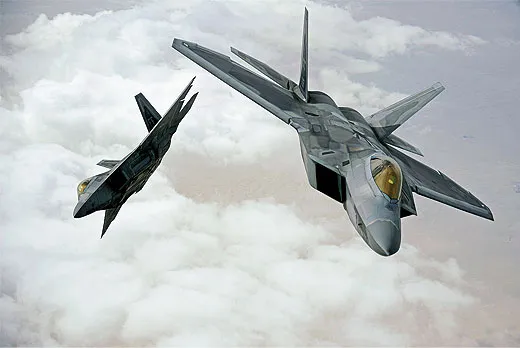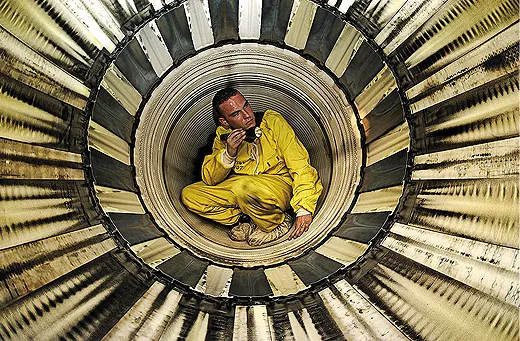The Last Gunslinger
The F-15C is the only dedicated dogfighter left in the U.S. military fleet. Why isn’t the Air Force replacing it?
/https://tf-cmsv2-smithsonianmag-media.s3.amazonaws.com/filer/Gunslinger2_FLASH.jpg)
While driving through downtown Mountain Home, Idaho, on a gray February morning, I notice something troubling: Mountain Home has no mountains. Later I learn why. In the 1880s, the town was relocated. Its original site was an Overton trail stagecoach stop called Rattlesnake Station. A post office, a farmhouse, and a few clapboard structures were nestled in the foothills of the Sawtooth Range, where snowy peaks soar above 10,000 feet. The outpost served a gunslinging clientele of trappers, miners, and explorers, and, true to the romance of the American west, survival there required a will and an ability to fight. But in 1883, the Oregon Short Line railroad laid tracks seven miles southeast, on the Snake River Plateau. A more comfortable life beckoned, so the town moved. And that’s when Mountain Home lost its soul.
Its rebirth began in August 1943, when the U.S. Army Air Forces built an airfield on the outskirts of town to train B-24 Liberator crews. Soon the base expanded, until it encompassed 134,000 acres. In 1991, the F-15 Eagles arrived. Built by McDonnell Douglas (now Boeing), the F-15 made its first flight on July 27, 1972, and the C model remains the only fighter in the U.S. arsenal designed exclusively for air-to-air combat. Its pilots have restored to Mountain Home the sensibility of the gunslinger, whose singular pursuit leaves no safety net: It’s kill or be killed.
But after more than 30 years in service, the F-15 dogfighters are becoming an endangered species. To blame are the multi-role, fifth generation Lockheed Martin F-22 Raptor and F-35 Lightning II. By 2025, the ambidextrous multi-roles, along with unmanned aerial vehicles (UAVs), will have replaced all F-15Cs, a drawdown that’s already under way. Some F-15Cs are headed to the Air National Guard; others are being cannibalized for parts. A handful of pilots will get reassigned to the F-22, but an unlucky few might end up holding the joystick controlling a UAV, or grounded at desk jobs.
For their part, Department of Defense wonks claim that America’s enemies reside in caves, unreachable by aircraft. F-15C pilots see it differently. The threat of an airborne attack has diminished, they say, precisely because the Eagle has maintained air dominance over the battlefield for nearly four decades. “We are a victim of our own success,” says Lieutenant Colonel Mark McGeorge, who is chief of flying operations and training at Air Combat Command at Langley Air Force Base in Hampton, Virginia, and has 2,800 hours in F-15s. “If we don’t maintain our advantage of air superiority, then maybe our enemies will decide to challenge our aircraft directly.”
“There are just not going to be enough airplanes anymore,” declares 42-year-old Lieutenant Colonel Jim Stratton. A Chicago native, Stratton is the commander of Mountain Home’s 390th Fighter Squadron, one of four under the 366th Fighter Wing. “We’re taking on more risk because some elements within the DOD assume that air superiority is going to be a given.” Stratton has flown combat missions in Kosovo and Iraq. To his dismay, his entire squadron—21 F-15Cs and 13 fighter pilots—will be disbanded by September.
Now you’d think the Eagle top guns—the pilots refer to each other as “Bros”—would be hankering to get behind the stick of an F-22 (and eventually an F-35, due in 2016), with all its “Gucci” technology, as 29-year-old Captain Benjamin Leestma puts it. But they’re not. “The thing is, [in multi-role fighters] there is so much information that you have to weed through to get to what you really care about,” says Leestma, Mountain Home’s chief of weapons and tactics. Pilots like Leestma joined the Air Force to fly the legendary F-15Cs. “I have spent six years working my tail off to get to the point where I am,” he says. “The jet is a twin-tail, twin-engine, combat-proven, air-dominant fighter. Being single-seat allows me to make and execute instant decisions without coordinating with another crew member. In my experience, the speed at which the pilot can make and execute decisions is often the key to success in air-to-air combat.” Leestma concedes that the F-22 and F-35 are indeed be-all, do-all workhorses, but complains that the pilots flying them rely too much on gadgetry and too little on grit. The Bros are a vanishing breed, bemoans another Eagle pilot. And they warn that mothballing F-15s while not pursuing a fifth generation air superiority jet—one designed principally for dogfighting—is a mistake, a risk to America’s national security.
The news is not all bad. Sweeping technological upgrades since its inception have rendered the F-15C a formidable 21st century weapon, while additional add-ons in the near-term will prolong its viability. What upsets the F-15C pilots at Mountain Home is that in the interim the Air Force will begin curtailing the Eagle’s mission as a dogfighter. If, by chance, the country goes to war where air dominance is contested, the multi-role platforms will supposedly handle dogfights just fine. But new recruits to the multi-role programs won’t spend long hours flying dogfight scenarios. Stick time is limited—operating an F-22 costs $50,800 an hour, compared to $31,800 for an Eagle—and there are just too many other systems, procedures, and missions to master.
The fifth generation assumption is that pilots will eliminate the enemy before having to engage at close range. “At the end of the day, if you are dogfighting in an F-22, lots of mistakes happened in the previous 80 miles,” says Stratton. But mistakes do happen. Stratton also worries that those who fly the multi-roles aren’t hardwired for air-to-air combat. Of his F-15C Bros, he says, “We attract a certain portion of the population to the job, guys who bring that controlled aggression and cunning and desire to never lose, no matter what the odds are.”
Last year I went to Cuba and for two weeks drove 1,100 miles around the island. No doubt you’ve seen photos of the vintage 1957 Chevys there, those pre-Castro leftovers that roam the countryside in mint condition, engines purring, as if they’re fresh off the lot. I had a chance to inspect one of these stalwart gems up close. Its owner showed me how he had retrofitted his with a diesel motor from a Mercedes-Benz, and installed air conditioning and a thumping audio system. Surely Chevy’s engineers never envisioned the kinds of modifications that have kept this classic alive in Cuba for a half-century. But its sturdy frame, modular architecture, and generous engine compartment left ample room for modernization. The story of the ’57 Chevy is the story of the F-15 Eagle.
Stratton walks me out to the Mountain Home flightline, where an icy wind scours the tarmac. F-15Cs are aligned like sentries, their wing pylons laden with air-to-air missiles. Maintenance crews scurry from airplane to airplane, checking and rechecking avionics, engine
specs, hydraulics, control surfaces, and weapons systems.
We approach Stratton’s F-15C where a fresh-faced kid has just finished hand-polishing the landing gear assembly. He sees us coming, jumps to his feet, and acknowledges Stratton, his commanding officer. I follow Stratton up an aluminum technician’s ladder. He slides into the cockpit while I stand on the ladder’s top rung. “Don’t touch anything,” he warns. “You could arm the weapons system.”
The dials and knobs are decrepit; nearly every painted surface is scuffed and chipped. The control stick looks like it might have been dragged behind a tractor for 60 miles. And I’m pretty sure that the tattered pilot’s seat came from the VW bus of a group of Deadheads, shortly after the ’77 spring tour. To discover where the magic happens, I have to peek beneath the forlorn facade. Integrated into both the interior and the exterior fuselage are several large compartments and caches. They once housed hefty pneumatic controls and bloated radar and weapons components that pre-dated the microcomputer revolution. But as technology shrank, the F-15’s flight systems got smaller and lighter, leaving room to cram in new innovations. Instead of languishing as decades passed, the Eagle got more agile and lethal.
By the 1980s, McDonnell Douglas engineers had gained enough space in the forward fuselage to add a second seat for the F-15E model, a potent air-to-ground strike fighter. It boasts under-wing fuel tanks to extend its range, a digital flight control system, low-altitude “tree-top” navigation, infrared night vision, and color cockpit displays. During Operation Desert Storm, F-15Es pounded Iraqi Scud missile sites, obliterated Saddam Hussein’s feeble air force, and rained cluster bombs on his Republican Guard troops. To detail the dozens of improvements since the Eagle’s debut—communications, navigation, propulsion, displays and instruments, electronic warfare, sensors, and weapons targeting—would drown you in acronyms. The list of upgrades that stokes F-15C pilots, however, is much shorter. Stratton has two favorites. The first is the Fighter Data Link, or “Fiddle.” In essence, Fiddle gathers flight data from other Fiddle-equipped aircraft and sews it into a single seamless display. In combination with other technology, Fiddle also collects information from airborne refueling tankers, E-3 airborne warning and control systems, and forces on the ground or at sea, even submarines. “It gives you a three-dimensional picture of the battlespace from a God’s-eye view,” says Stratton. “As a flight lead managing four airplanes and sometimes up to 14, I used to have to put what all the guys were telling me in my ear into this three-dimensional picture in my head. Now that is all presented to me graphically on my Fiddle display.”
Another prized advance is the Joint Helmet Mounted Cuing System. “We just call it The Helmet, with the emphasis on the,” says Stratton. From his gear locker in the ready room, Stratton offers me his helmet to inspect. The visor is nearly opaque, and the shell is embedded with magnetic sensors that transmit real-time spatial data from a pilot’s head position to receivers inside the cockpit. During a dogfight, Stratton can cue and fire weapons at attacking aircraft, even during high-G maneuvers, simply by glancing at his enemy. “I really don’t know how we did missions before we had the helmet,”he admits.
Leestma, who has racked up more than 900 F-15C hours, tells me about a recent radar makeover called Active Electronically Scanned Array, or AESA. (As part of an Air Force F-15 program known as Golden Eagle, C-model airframes are undergoing stress tests, and those with the least wear and tear will receive an AESA system.) Conventional radars make sweeps that show solid objects as pings or blips on a head-up display. With each radar pass, the process repeats. The problem is that in a dynamic air-to-air situation, bad things can happen between cycles. “By the time the radar we have now does all its math, you might have something completely different out there,” says Leestma. AESA is fluid and encompassing. It uses multiple frequencies to continuously scan the skies, then stitches together a real-time radar image. Leestma explains, “It paints the picture of anything moving out in front of you and constantly updates it.”
The economy is quashing spendy military ventures, and fifth generation fighters are already suffering the wrath of the red pen. With every F-22 costing as much as $227 million, according to the Rand Project Air Force analytical team, President Obama ordered production halted at 187 jets and slashed further funding. The ongoing F-35 development program, a relative bargain at $155 million per airplane, is already over budget and behind schedule, causing Congressional colic. Cutbacks to its $300 billion-plus program are virtually certain. That’s just fine with F-15C pilots, who believe their dogfighters are plenty capable of defending America’s turf for the foreseeable future. “The F-15C is still our frontline air superiority fighter,” says Major John Boehm, a veteran F-15C pilot and program element monitor at Langley, whose job entails setting future hardware and software requirements for the Eagle fleet. “It was overbuilt in a good way, designed with enough extra margins to allow us to have all the options we have today for upgrading. Some call it the world’s greatest fighter based on its proven legacy. It has a kill ratio of 104-0.”
In a dogfight where an F-15C might face off against a Russian Sukhoi Su-27 or China’s Shenyang J-11, both fourth generation fighters, or even the mighty fifth generation F-22, Eagle pilots are confident they’d triumph. In fact, two pilots told me that if an F-22 uses its thrust vectoring to do a post-stall maneuver during a dogfight, there is a specific move that they can execute to win. This classified tactic is the F-15C pilot’s ace in the hole. Stratton acknowledges the tactic, but cautions that in air-to-air combat, no one move will always solve a particular problem. “Rather, it is much more likely that the F-15 pilot was able to fly his aircraft to its maximum potential [while] the F-22 pilot made a maneuver error. While the machine is important, and the F-22 enjoys a maneuvering envelope advantage over almost every aircraft, the man in the cockpit tilts the balance between success and failure. A pilot that is flying his F-15C to its maximum potential is a very tough adversary to defeat.”
A number of features make the F-15C an ideal dogfighter. With a thrust-to-weight ratio greater than 1:1, it is one of the few fighters with that power advantage, so it can accelerate during a vertical climb. And the large lifting surface of the fuselage enables the Eagle to keep flying even with a lot of battle damage.
The Eagle also blends a computerized system with old-fashioned manual controls. Other fighters, particularly the F-22, are pure fly-by-wire. In the F-15C, say its pilots, a pilot can override his computer warnings and go beyond the edge to get that little bit of boost to survive. In the F-22, the computer system simply won’t allow that, as it thinks the airplane will break up in flight—not good when you’re in the midst of a dogfight and need to execute tactical maneuvers.
Major David Skalicky, leader of the F-22 Aerial Demonstration Team, and a former F-15C pilot, disputes the F-15C pilots’ claim of an advantage. “The F-22 will aerodynamically out-perform and out-power the F-15 in every scenario,” says Skalicky. “That isn’t to say that on exceptionally rare occasions, F-22 pilots haven’t lost to F-15 pilots in practice dogfights due to poor maneuver selection. However, the credit for victory in that scenario belongs to the F-15 pilot, not the airframe.”
The majority of active-duty Eagle pilots flying today were born after the aircraft went into service. So to find out if anyone expected the F-15 to remain a viable dogfighter for more than a quarter-century, I tracked down those who designed and built it. They gather every three years for a reunion on the anniversary of the F-15’s inaugural flight. Donn Byrnes, who flew F-86 Sabres and F-84 Thunderjets in the 1950s and later spent six years on the Air Force side of the team designing and developing the SR-71 Blackbird, was the system program office project manager for the F-15 airframe. He got involved with the Eagle program in 1969, coordinating with McDonnell Douglas engineers during the early blueprint stages, and stayed through mid-1975.
The 78-year-old retired colonel is panting when I reach him by telephone at his home in Los Lunas, New Mexico. “Sorry, I just hauled in a cord of firewood,” explains Byrnes, who wrote the book Air Superiority Blue, a retelling of the Eagle’s birth. I ask Byrnes what spawned the sudden demand for an air superiority fighter, something the Air Force hadn’t shown an interest in since it procured the P-51 Mustang in 1940. “We had our tail feathers burned off in Vietnam by the MiG-19, and if we went to war with Russia, we would be in deep trouble,” he says. “So we wanted to put together a machine that when fitted with a skillful pilot, who is aggressive and courageous, would have the ability to turn and burn and kill whatever he comes across.”
Byrnes agrees with most Eagle pilots that the F-15’s longevity is a direct result of its singular mission. “We designed the F-15 to do what we wanted it to do, and nothing else.” Byrnes is a critic of the multi-role concept: “You don’t want to make an airplane be the Swiss Army knife of a fighter,” he says. “I’m absolutely not in love with the idea. The F-35 is the worst nightmare of hardware idiocy. It does everything wrong. You need a long-legged fighter, not a short, fat one.”
Byrnes credits chief Air Force engineer Frederick Rall for championing the F-15’s robust and redundant design. “His mantra was: The first failure can’t kill you, and that the only failure we could define that you could not recover from was the stick busting off in the cockpit.” Consider the story of Israeli F-15 pilot Zivi Nedivi, who during a training exercise in 1983 hit and destroyed an A-4 Skyhawk. The collision sheared off all but two feet of Nedivi’s right wing. He punched the afterburners to generate lift over the fuselage and managed to land.
The Air Force purchased its last F-15 in 2001, and the 499 Eagles that remain in the fleet (C, D, and E models) are, on average, 20 years old. Meanwhile, foreign sales, mainly to Singapore and South Korea, could keep manufacturing plants at Boeing chugging along for at least another few years. “Given the end of the F-22 program, if force structure begins to look really bad, the Air Force could buy a few more F-15s,” says Richard Aboulafia, vice president of the Teal Group, a military consulting firm in Fairfax, Virginia. “Every day the line stays open, it keeps alive that chance.” A new prototype, the F-15 Silent Eagle, has a stealthy, radar-absorbent coating. “Singapore and South Korea are getting planes that are extremely capable, with the latest systems and sensors,” says Aboulafia.
For a guy integral to the design of the world’s greatest fighter jet, you’d think Byrnes might be a bit wistful to see the F-15 destined for the boneyard. He’s not. In fact, he’s dismayed that the Air Force never acquired a fifth generation dogfighter. “It’s the only fighter in modern times that has been in constant production for 35 years—who would have thought—and I think it’s because we didn’t have our act together to buy another one,” he says. “When you kick pilots out in the dark and say to them, ‘Go find what that is and kill it,’ riding an old horse is not the way to succeed. You are asking them to take an airplane guaranteed for 4,000 flight hours with airframes that already have about 6,000—way past their approved fatigue life—and then rat race with them.”
Very few Eagle pilots think the F-22 or F-35 will eliminate the need for a dedicated air superiority fighter with a skilled pilot. If you’re a multi-role pilot, “intel hands you a target package, you fly the black line, drop the bomb, and come back,” says Stratton. “Multi-roles can do different missions, but their primary mission—the reason we bought them—is to drop bombs. A guy that is going to go drop a bomb has been given a discrete target. There is no decision-making. In the F-15C, we’re told to protect a battlespace. It’s a much more fluid environment.”
UAVs, such as Predator drones and their offspring, which undoubtedly will be more sophisticated, could take on dogfights in the future. In fact, some experts predict the F-35 will be the last manned fighter ever built. This deeply troubles F-15C pilots, who know that once their Eagles are scrapped, they could get reassigned to UAV duty. Imagine training to race a Formula One speedster, only to be told that you’ll be touring the track in a Prius. “I’d shoot myself,” says Leestma. “[Flying UAVs] is a totally different mindset. My skills are not transferable. I am putting myself in a position where my pink body is on the line. I’ve gotta kill a guy before he kills me…. Personally I don’t think there is a replacement for [a pilot who would] actually make that decision to hit the pickle button and shoot somebody.”
listening to Leestma, I can’t help recalling what happened when the Oregon Short Line arrived in Idaho. Survival no longer hinged on tenacity and resolve. The multi-role jets might herald the future of warfare, with their big bag of tricks to defend the skies. But in both culture and cunning, the dogfighters are the descendants of the gunslingers at Rattlesnake Station, who never went anywhere without their six-shooters, and at high noon, knew how to kill with terrifying precision.
Based in Boulder, Colorado, Michael Behar writes about aerospace, adventure travel, science, and environmental issues.
